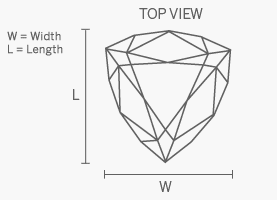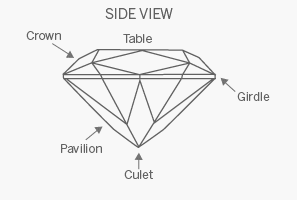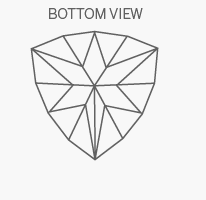Trilliant Cut Diamonds Shape
The Essential 7C's
Every diamond has its own story, and every lady her own style.
At this point it should be noted that the shape of a diamond can also be referred to as its "cut", like a round or princess cut. However, this should not be confused with the more commonly used term of diamond cut, which describes how well the diamond has been polished from the raw material (see section on diamond cut).
At Seventy Seven Diamonds we cater to the detailed wishes of every customer and want to ensure that they are well-informed about every diamond shape available. Our selection of beautiful shapes is accompanied by detailed information, images and recommendations on the uniqueness, the history and background, and the ideal ratio of every cut.
Trilliant Cut Diamonds
1. The Basics | 2. Features | 3. Expert Advice | 4. History
1. The Basics
Also referred to as: TRILLION, TRILLIAN or TRIELLE
| Unique Features |
Facets |
L/W Ratio |
Origin |
Expert Tip |
| Triangular shape, great fire and sharp brilliance. |
31 or 50 |
Ideally 1.00 |
1962 |
Hides inclusions well. |
2. Features



The trillion cut is a triangular shape comprised of three equal sides and 31 or 50 facets depending on whether the diamonds are used as solitaires or accent stones.
For solitaires, a curved or convex cut is employed, whereas accent stones are cut uncurved or concave. Additional variations include round-cornered triangular, modified shield cuts and triangular step cuts. The trilliant’s unique style has great fire and displays sharp brilliance if the stone is cut to the correct depth.
Trilliant cut diamonds are most often used as side stones to compliment larger solitaire stones in engagement rings, although they also make for a perfect solitaire stone themselves considering their unparalleled brilliance and fire.
3. Expert Advice
Trilliant cut diamonds make for striking accent or side stones, or offer a striking option for someone after a brilliant and unique solitaire.
Depth is an important factor to consider in trillion cuts (especially where solitaires are concerned), as this can greatly affect the fire and brilliance of the stone. A well cut trillion with great fire and brilliance can also hide inclusions fairly well.
4. History & Background
Variations of this triangular cut have appeared over the years, with different names such as “trillion” or “trielle” being used. The modern version of the trilliant was first created by New-York based diamond merchant Leon Finker in the early 1960s. His son, Marvin Finker, later patented the design in the early 1970s. This same design is now known as the “Trielle”. Other diamond merchants such as the Henry Meyer Diamond Company also created their own version of this three-sided stone around the same time, however, the Finker family are considered to be the first creators of the trillion or trilliant. Today, both terms are used interchangeably to describe a triangular-shaped diamond.

Where next?
We offer trilliant cut diamonds and trilliant cut engagement rings on request. Please get in touch if you're interested.
If you would like to read more about diamond education, please click here.